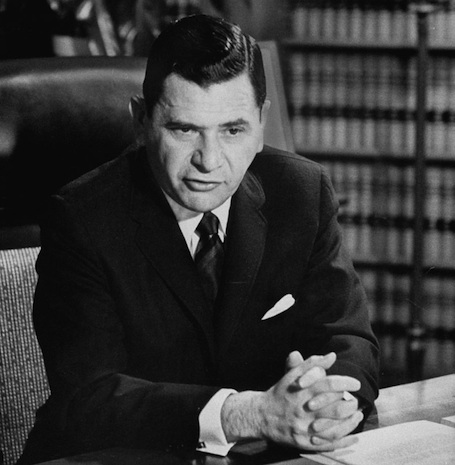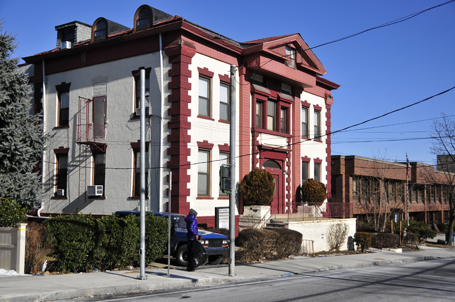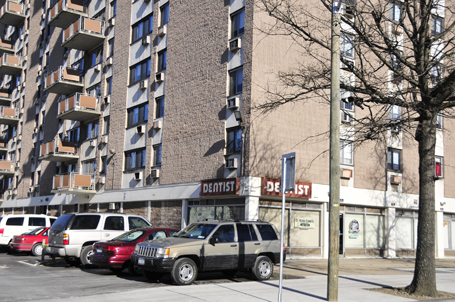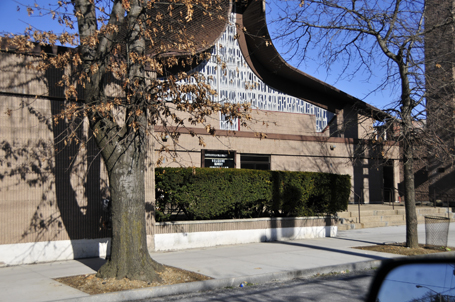
Lincoln School Desegregation Today (Part VI): The Defense Presents and Judge Kaufman Decides
 |
Lincoln School Desegregation Today: Part I - Early Gerrymandering
Lincoln School Desegregation Today: Part II - The Dodson Report
Lincoln School Desegregation Today: Part III - Frustration Grows
Lincoln School Desegregation Today: Part IV - Civil DIsobedience
Lincoln School Desegregation Today: Part V - The Trial, Plaintiff's Case
Mr. Zuber, had set up a compelling case. He seemed to have the sympathy of the judge. His arguments were well prepared, his witnesses convincing. The cross examinations from the defense were limited.
Judge Kaufman tried to mediate the sides, hoping for a settlement without a court decision. John Kaplan writes "the judge had on four or five occasions during the trial invited counsel for both sides into his chambers and tried to bring about a settlement. … On each of these occasions his attempts were rebuffed by the school board, while Mr. Zuber, although not committing himself to any specific compromise, indicated that he was prepared to sit down and talk." The judge even offered ideas and solutions, which is atypical, to no avail.
 |
| Building on Lincoln Avenue |
The Defense Presents
The first witness for the defense was Kenneth Low, who had been a BOE member for ten years but was not currently on the board. He was president when the board last voted to rebuild Lincoln. He had an amazing resume in race relations including: member and chairman of the Mayor's Interracial Committee, and chairman of the Council for Unity, a member of the Urban League and the chairman of the Westchester County Council of New York State Commission against Discrimination.
During his testimony Kenneth Low went through every possible scenario for solving the "racial imbalance" problem and why they would not work. He described the school board's votes, the disputes, and the reasoning. He talked about not having any other sites for a new Lincoln school; no method of redrawing district lines; felt transportation would have been unworkable for bussing the Lincoln children, too expensive; permitting transfers would soon make Mayflower and Washington racially imbalanced when the white families put their children in parochial schools; the city was at it's "tax limit"; and more. He cited every reason why Lincoln could not be changed and the school rebuilt where it stood. John Kaplan related another argument from Kenneth Low:
"although parts of the Lincoln zone contain well-maintained private homes, the area adjacent to the school can only be called a crime-ridden slum. The board hoped that this area would be redeveloped and that middle-income housing would be built there which might change its residential character. The State authorities, however, had ruled that they would not approve middle-income housing unless a modern school was erected nearby."
Judge Kaufman questioned Kenneth Low extensively, feeling that there "is no such thing as an insoluble problem", writes John Kaplan.
Mr. Zuber cross-examined Kenneth Low about the "misleading and threatening tone" of the advertisement produced by the school district. But Kenneth Low defended the board's actions and said that they voted against building a 2nd high school on the north end of the city because it would lead to segregation and "moved a Lincoln boundary line to send some 27 Negroes from Lincoln school into nearby Washington".
John Kaplan writes "The defense presented a number of brief witnesses: Lee Kahan and Dr. Joseph Robitaille, past and present principals, respectively, of the Lincoln school; Dr. Barbara Mason, principal of the Roosevelt school; Dr. Joseph Halliwell, principal of the Webster school; Dr. Edward J. McCleary, Superintendent of Schools of East Meadows, Long Island; and Sim Joe Smith, Assistant Superintendent of Schools in New Rochelle." They answered questions about teacher turnover and the reasons for neighborhood schools.
The Hearing becomes the Trial
At this point Mr. Weiss, attorney for New Rochelle requested that the hearing should be considered the final trial. This shows that the defense was confident they were winning, though it was clear to observers, including John Kaplan, that they were not.
The defense was not well prepared, had not researched the history of gerrymandering by the district, did not have necessary information when it was required, and several of their witnesses were not available to testify in person, but rather submitted via affidavit. Mr. Weiss's confidence was misplaced. Judge Kaufman had warned that he could not weigh testimony entered via affidavit with as much weight as when witnesses appeared in court because he would be unable to ask them questions and they would not be cross examined. Mr. Zuber agreed to accept the hearing as a trial, satisfied that he had properly presented his case.
Closing Arguments
In closing arguments Mr. Weiss argued that the neighborhood school policy was policy and then could not be reviewed by the courts. Mr. Weiss claimed so long as the school authorities had not deliberately caused the segregation, there was no violation of constitutional law.
In closing arguments Mr. Zuber claimed not only was Lincoln a segregated school but also that the Board of Education had deliberately made Lincoln a segregated school. The BOE had the intention of confining as many Negroes as possible in that school, and that the present school board had, without reason or excuse, failed to do anything to remedy that segregation, paraphrased from John Kaplan's report.
 |
| Apartment Building on Lincoln Avenue |
The Decision
The historic decision of Judge Irving R. Kaufman, dated Jan. 24, 1961, is available in the New Rochelle Public Library in the book called Crisis in the Public Schools, based on the Reports by Dan Dodson starting on page 23. The judge maps out the history of the situation in New Rochelle schools succinctly. He explains the evolution of neighborhood schools in New Rochelle for the previous 100 years.
The judge writes "a policy of gerrymandering was instituted (subsequent to 1930) that led to the confining of Negroes within the Lincoln School district by redrawing the district lines to coincide with Negro population movements. In addition to this gerrymandering, the Board instituted further policies to assure that the Lincoln School District would remain Negro, (also) to relieve white children of the burden of attending a predominantly Negro school. Thus, up until 1949, white children remaining in the Lincoln district were allowed to transfer to other elementary schools. This policy produced the anomaly … of children living in adjoining houses attending different schools solely on the basis of their race."
Judge Kaufman said "As a result of (public) agitation, the Board passed a resolution, on Jan. 11, 1949, ending the policy of transferring white children out of the Lincoln School … This, it has done nothing to eliminate the effects of this gerrymandering undertaken previously. Rather it has chosen to maintain the status quo, imposing, in effect, a freeze on the artificially created boundaries of the Lincoln district. When it determined to maintain the status quo, the Board could hardly have been unaware that this would necessarily perpetuate Lincoln as a predominantly Negro school."
Judge condemns the boards 11 years of inaction
The Judge went on "For eleven years, responsible civic-minded organizations and groups have urged that something be done to correct the Lincoln situation; for eleven years the Board has discussed the problem, hired experts, made surveys, and constantly reiterated its belief in racial equality and the necessity for equal opportunities. But, in these eleven years, it has taken no action whatsoever to alter the racial imbalance in the Lincoln School. It has met the problem with mere words, barren of meaning, for they were never followed by deeds."
The judge speaks about the BOE "I hold that the Board of Education of New Rochelle by its conduct in the years prior to 1949, created and established the Lincoln School as a segregated, Negro school. Thus formulated, the present case falls squarely within the plain meaning of the Brown decision." The judge discredits the school districts argument that the school is 94% black not 100% black because the contention "misconstrues the underlying premise of the Brown rationale".
The judge reprimands school officials. "The conduct of responsible school officials has operated to deny to Negro children the opportunities for a full and meaningful educational experience guaranteed to them by the Fourteenth Amendment. Further, the fact that the Lincoln School contains approximately 6% whites, surely cannot divest Lincoln of its segregated character. In a community such as New Rochelle, the presence of some 29 white children certainly does not afford the 454 Negro children in the school the education and social contacts and interaction envisioned by Brown."
The Judge cannot accept that there is no solution to this problem
"I cannot accept the proposition that in this relatively small community in the north, men of good will, wisdom on ingenuity could not have devised a plan for the orderly desegregation of the Lincoln School … I also conclude that if a Board of education enters into a course of conduct motivated by a purposeful desire to perpetuate and maintain a segregated school, the constitutional rights of those confined within this segregated establishment have been violated … overly-rigid adherence to artificially created boundary lines".
He says there is no difference between "de jure" or "de facto" segregation. De facto means "in fact". De jure means "by law". The New Rochelle school district said that they had no laws forcing segregation. But in fact, in actuality, the schools were segregated.
"The Board is hereby ordered to present to this Court, on or before April 14, 1961, a plan for desegregation in accordance with this Opinion, said desegregation to begin no later than the start of the 1961-1962 school year." The date was later extended to May 3rd.
 |
| Church on Lincoln Avenue |
Next, we will explain the plans that were submitted by the school district, how they were rejected by the judge, and the ruling by the judge on what became the specific guidelines the school district was ordered to follow.
Lincoln School Desegregation Today (Part VII): The Plans and the Ruling